|
|
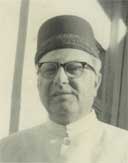 |
|
Sheheryar Kaoosji,
1971 |
Mr. Sheheryar Kaoosji is remembered as a
caring man, who lived a life helping everyone selflessly. Scion of a
respected Parsi family of Hyderabad-Deccan, India, he was the twelfth of
fourteen children of Kaoosji Dadabhai Talukhdar and Gulbanoo of the
Viccaji Meherji family.
His father
had served the Nizam of Hyderabad as a talukhdar (head of a district) and
in the tradition of the day adopted his vocation as his name. With Kaoosji
Talukhdar’s passing his children adopted their father’s first name as
their family name…hence, the Kaoosji family of Hyderabad.
Sheheryar’s
brothers and sisters were either civil servants or teachers. Most of them
had a special attraction to academic life and enjoyed intellectual
exchanges, often hosting the local Persian intellectual club, the
Bazm-e-Saadi, in their home.
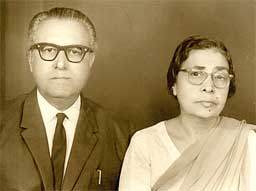 |
|
Sheheryar and Parvis Kaoosji, 1967 |
Sheheryar’s earliest recollection of his
father was of a man who had lost most of his eye-sight to cataracts. He
had watched his elder brother, Dadabhai, read aloud to their father, from
his vast collection of Farsi and Urdu books. Those early impressions no
doubt left a lasting impact on the young Sheheryar, who lost his father to
the influenza epidemic of 1918 when he was barely 8-years old. So when he
grew up and time came to choose a career, he dedicated his life to
rehabilitate the blind, in a personal tribute to the father he adored,
respected and had such little time to know well.
He was a
student of the prestigious St. George’s Grammar School and kept in close
touch with his alma mater all his life. His sons followed him to the same
school. Later in his career, wherever occasion arose, he paid homage to
the school and his teachers, especially the Principal, Canon F.C. Phillip.
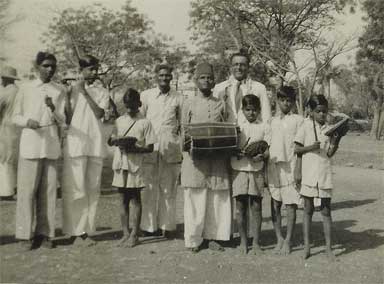 |
|
Sheheryar Kaoosji with
School for the Blind Band |
Soon after
graduating from the Nizam College where he led an active student life as a
hockey player, an amateur actor and debater, he went to Calcutta, to the
Behala School for the Blind where he qualified himself for his chosen
profession. Upon returning he started work to establish an institution for
the rehabilitation of the Blind in Hyderabad. As the Headmaster of the
Government School for the Blind he pioneered their education in Hyderabad,
and advocated for the welfare and mainstreaming of his students as
productive members of society. He fought successfully to admit his
students into the Osmania University, and today there are several well
educated visually handicapped men and women who are active in various
walks of life, thanks to his vision, perseverance and energy.
His career
and family life ran a close parallel. Just as he was settling down in his
career he married Parvis Taraporewalla, on January 5, 1941. She held a
Diploma from the Royal Drawing Society, London, and was the art and
needlework teacher at the Mahbubia Girls School. She had attended the
same school as a student, and worked there as a teacher, and retired after
a distinguished 35 year career in 1970. They had three children.
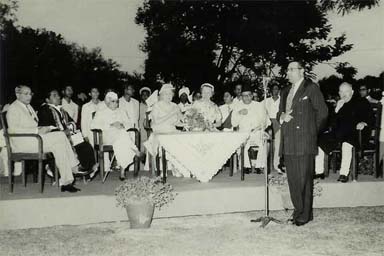 |
|
Kaoosji at Helen
Keller Reception |
Another
passion and lifetime involvement of Sheheryar’s was the Boy Scouts. He
joined the scouting movement as a student of the St. George’s Grammar
School, and remained a scout for life. As a school teacher he was also a
Boy Scout Commissioner, and at every institution he headed, he made sure
to introduce a Boy Scouts troop. He was very proud of the Blind Boy’s
Scout Troop in his school, which had one of the better known marching
bands among scout troops in town.
A civic
minded and responsible citizen, he was very concerned about the communal
discord between Muslims and Hindus following Indian Independence in 1947.
The atrocious impact on human life and suffering brought on by the events
following the partition of India was as severe on Hyderabad as anywhere
else. But it was minimized in the wake of the international dispute over
Kashmir that still looms large over the subcontinent more than half a
century later. The Nizam of Hyderabad (the largest native princely state)
had decided to remain an independent monarch and refused to join the newly
created India or Pakistan. He took his impractical and fairy tale case to
the United Nations, and even engaged the eminent British constitutional
jurist Sir Walter Monckton to advise and represent him. But this fancy
legal battle took a nasty turn on the streets and neighborhoods of
Hyderabad, which were witnessing sporadic communal rioting and violence.
Extremist groups of Muslims supported the Nizam, and Hindus wanted him to
join the newly downsized India. A peace-keeping force was created and
Sheheryar Kaoosji heard his calling, and promptly volunteered to be
Commander of the Civic Guards Corps in his neighborhood of Gunfoundry. He
was 36 years old, a father of two sons, 6 and 4 years old, and a soon to
be born daughter. Along with his corps of guards, both Hindu and Muslim,
he as a Parsi held the balance of peace and commanded their respect and
loyalty. He patrolled the streets with them every night, keeping the
peace. On one night he almost lost his life while breaking up a brawl
between warring gangs. Years later he used to proudly show us the spear
gash between his third and fourth ribs, always grateful that it was on his
right side.
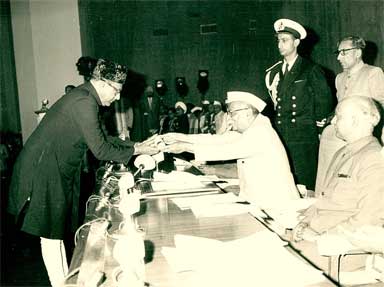 |
|
Sheheryar Kaoosji
receiving the National Award, 1960 |
Soon after
Indian Independence, Sheheryar Kaoosji was awarded a Colombo Plan
Fellowship and spent two years studying practical implementation of modern
social work techniques at the University of Adelaide, in Australia. Social
work was as much his passion as the education of the blind. When he
returned he was disappointed that the new State government did not take
any action to utilize his training and education in the broader social
services field. But he was happy to return to his School for the Blind.
In 1955
under the cultural outreach initiated by the Eisenhower administration,
the renowned Dr. Helen Keller visited India. Sheheryar Kaoosji served as
the Liaison Officer for her visit to Hyderabad. He was always very
thrilled that he was fortunate to meet and host a world leader in the
rehabilitation of the handicapped. Those present at the Civic Reception
recall his passionate and oratorical introduction of Dr. Helen Keller.
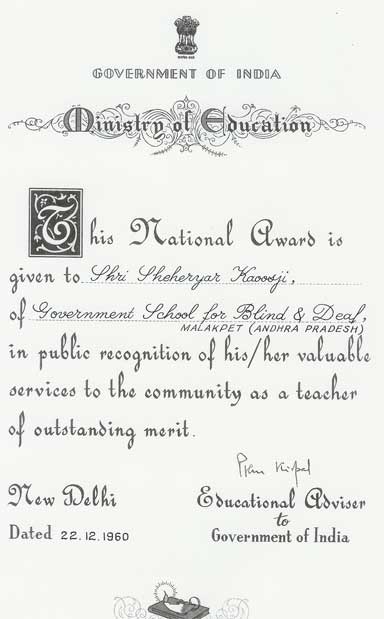 |
|
Sheheryar Kaoosji
Award Citation |
In 1956, five years after his return from
Australia his services were loaned by the Andhra Pradesh State Government
on a special assignment as Superintendent of the quasi-government Victoria
Memorial Home, an orphanage plagued with corruption and mismanagement.
The orphans had been neglected, and funds for their education and
rehabilitation had been swindled. The institution at that time housed a
couple of hundred orphans most of them a sad reminder of the Police Action
of September 13, 1948, when Hyderabad was annexed by Free India. The army
under General J.N. Chaudhuri overran the district of Mahbubnagar killing
many civilians and leaving hundreds of orphans. It fell on Sheheryar
Kaoosji’s watch once more, to close another chapter of the horrors that
India’s partition brought. He rehabilitated over a hundred young men and
women. He found suitable working class men to marry the young women, most
of them illiterate with few skills. He used his influence and friendships
with old classmates from school and college, to hire young men as
apprentices and put them on a road to self sufficiency. He introduced
vocational training in the institution. Within a few years he transformed
the Victoria Memorial Home from being a warehouse for orphans into an
effective rehabilitative institution it was established to be. In 1959,
once again, he happily returned to the School for the Blind and led it
till his retirement in the late 1960s.
Sheheryar
Kaoosji’s professional work was singled out for honor by the Government of
India. In 1960 he was the first recipient of the National Award for
Teachers, conferred personally by Dr. Rajendra Prasad, the first President
of the Republic of India.
He was a
very intellectual man, and had a profound interest in comparative
religious studies. He loved to compare and study religion as a process of
human development. A devout Zoroastrian, he drew upon his knowledge to
study and comment on the inter-twining history of the religions of the
world. His best work in this area is an article he researched and wrote at
the time the world was celebrating the 2,500th Anniversary of
Cyrus the Great. Titled “Cyrus the Great and his World Embracing
Personality and Humanity in the Light of the Holy Quran and the Holy Bible”,
his paper effortlessly links a scholarly deduction of the references to
“Zul Qarnain” in the Quran and the Jewish scriptures to conclude that it
is no other than Cyrus the Great. He could speak for hours quoting from
Jewish, Christian, Islamic, Buddhist, Hindu and Zoroastrian teachings, and
raising religious discussion and deliberation to a higher plane, always
critical of dogma and ritual in every religion. He maintained that
professional priesthood often did great injustice to the principles of any
faith, by introducing dogma into religious discussions. He was a very
popular speaker at Muslim gatherings during the celebrations of the
Prophet’s Birthday.
He also had
a great sense of humor and was an excellent actor. The life of any party,
he never hesitated to spontaneously entertain young and old alike. We
fondly remember when he surprised us at a large Nowroze gathering of the
extended Kaoosji family and friends. He dressed up in his sister’s purple
gara (embroidered Parsi Sari) and stumbled into the dining
hall, leaning on a cane and mimicking a well known dowager in the funniest
Parsi Engrati (English & Gujarati). He acted out how she used to
carry her age and status around, pushing children aside to grab the first
seat at free gambhars in Secunderabad.
After his
retirement he kept busy in the social welfare arena, managing a shelter
for women called “Aram Ghar” (Rest Home), and for the last four
years of his life he managed the administrative office of the Parsi
Zoroastrian Anjuman of Hyderabad & Secunderabad.
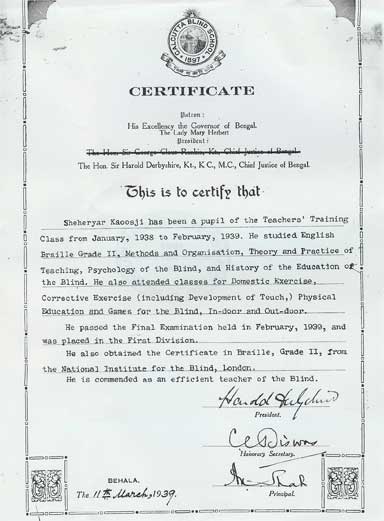 |
|
Sheheryar Kaoosji
Braille Diploma |
When he
became administratively responsible for the Anjuman’s affairs, it brought
him closer to issues related to Dakhma Nashini. For years I had
accompanied him to funerals of relatives and friends, and he kept getting
more and more disturbed about the urban sprawl that brought housing right
to the compound walls of the Bansilalpet Dakhma in Secunderabad.
From being a remote and isolated Dakhma, it was now uncomfortably
surrounded by a neighborhood, which was getting equally uncomfortable
about its presence. The Parsis left the carting of the cortège through the
crowded streets to the poorly paid Nussasalars (professional pall
bearers), while the family members themselves whizzed in and out in their
cars. But my father always walked behind the cortège, and personally
witnessed the verbal abuse by the neighbors, objecting to this hazardous
nuisance in their neighborhood. The Dakhma, with all its
environmental, ethical and philosophical glory had become an anachronism.
Worse was happening, and continues today, at the Towers of Silence in
Bombay. These towers, in turn dwarfed by towering apartment buildings lie
open to the view of the neighbors, who watch the slow decomposition and
devouring of human bodies by chained vultures, insects and the tropical
climate. All in the midst of this cosmopolitan metropolis.
For
Sheheryar Kaoosji, it was difficult to claim cultural elegance, neighborly
love and charity as the cornerstones of faith for a practicing
Zoroastrian, while simultaneously disregarding basic human decency,
sanitation, aesthetics and respect of other human beings. He objected to
adhering to a system that was a culturally abhorrent carryover of an
archaic custom, designed for a different geography of remote mountains and
deserts of Persia, and the culture of another era.
Ever a
problem solver, he sought to open a dialog to convert the Dakhma
property into a graveyard. This was not a new idea. A hundred miles away,
in Nizamabad, there was a properly consecrated Parsi Aramgah (A
resting place … graveyard). And, there were many more all over
India. He had visited Nizamabad and maintained that this is the best
compromise the Parsis could make to live in harmony as good citizens, and
to ensure our practices meet acceptable 20th century standards
of sanitation, aesthetics and lead to acceptance in the communities where
Zoroastrians live as microscopic minorities.
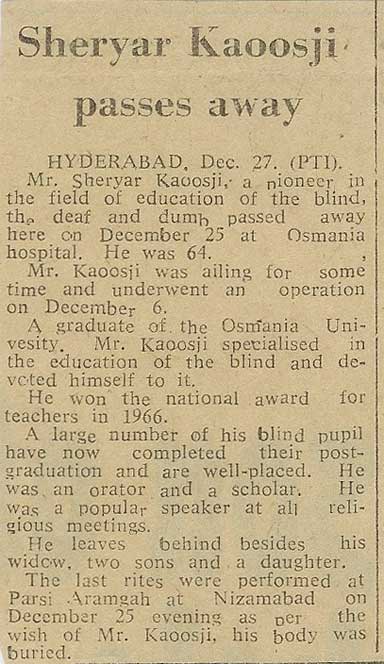 |
|
Sheheryar Kaoosji
Demise News Item Deccan Chronicle 1974 |
Then the
unexpected happened. Apparently in good health, but having ignored his
personal self for years, he had a relapse and surgery could not save him.
On December 25th 1974, which was Christmas of the Christians,
Eid-ul=Fitr of the Moslems and Ekadasi of the Hindus … three holy days of
three major faiths, he passed away at Osmania General Hospital in
Hyderabad. He was 64 years old. The only way we could honor the one
unfinished business of his life, was to lay him to rest in that Aramgah
in Nizamabad, which we did with great sorrow and pride.
This,
despite the most venomous attacks by so-called elders of the Parsi Anjuman
he served who prohibited the Mobed Sahebs, from entering our house to
conduct funeral prayers. The Mobed Sahebs, as employees of the Anjuman
had no option but to obey their employers. That was probably for the best,
because Sheheryar Kaoosji encouraged everyone to take an active and
personal role in all prayers and ceremonials. He himself had prayed and
conducted the Zoroastrian part of my marriage to Irene, while her uncle
Benjamin Israel blessed us with Hebrew prayers, at our civil wedding just
three years earlier in 1971. So, along with my Mother, siblings, aunts and
uncles, we had the privilege to say our heartfelt farewell to him with
Zoroastrian prayers, as we laid him to rest according to his wishes.
I look back nearly thirty years later at this
episode as a lost opportunity for the Parsi community to make a mature
societal decision. But, for the extended Kaoosji family, a pioneer act
has been fulfilled in honor of Sheheryar Kaoosji. Since 1974 all deceased
members of Hyderabad’s Kaoosji, Taraporewalla, Bastawalla, Dubash and
Mistry families have been either buried or cremated.
In closing
this tribute, I must add that Sheheryar Kaoosji loved to recite poetry,
whether it was in English, Farsi or Urdu, and one of his favorite poems
was the classic “Elegy Written in a Country Churchyard” by Thomas Gray,
and I quote the final verse of The Epitaph:
No
farther seek his merits to disclose,
Or draw his frailties from their dread abode,
(There they alike in trembling hope repose,)
The bosom of his father and his God. |